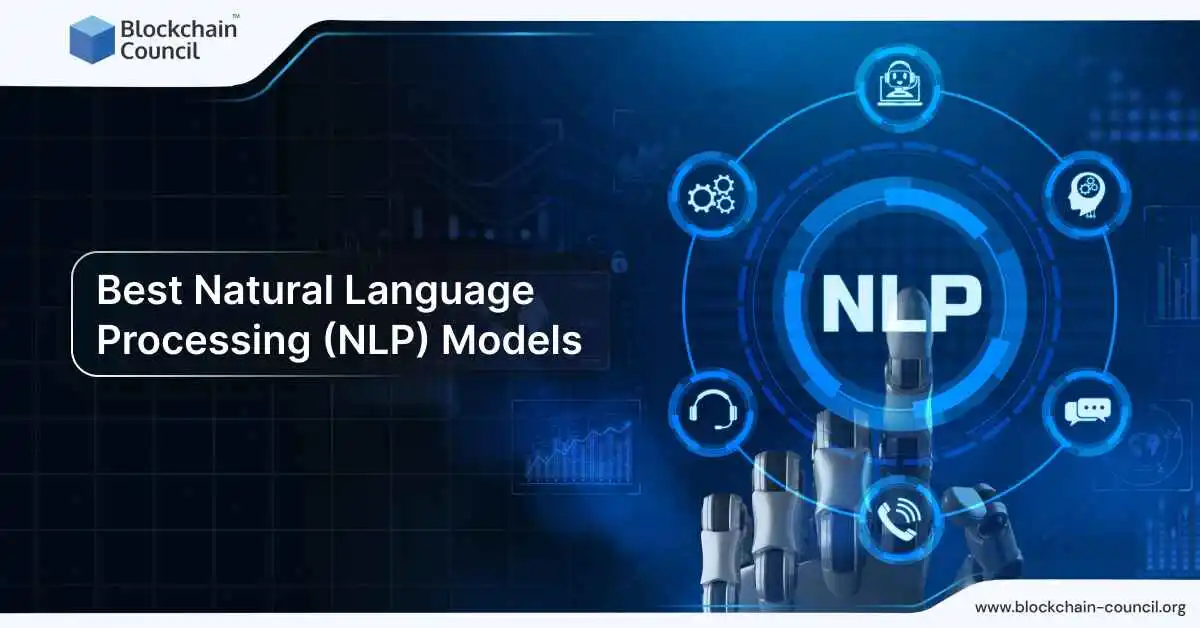
- Blockchain Council
- January 31, 2025
Natural Language Processing (NLP) is a branch of AI focused on how computers interact with human language. It enables machines to understand, interpret, and produce human language in ways that make sense. Over time, many models have been developed, each with its own features and uses.
Best NLP Models
GPT-4 (Generative Pre-trained Transformer 4)
GPT-4, created by OpenAI, is known for its advanced language abilities. Building on its previous versions, GPT-4 uses a transformer-based structure that effectively generates text that fits the context. It can handle various tasks like text creation, translation, and solving complex problems. So it is useful for both general and specific needs. For instance, GPT-4 can draft emails, summarize lengthy texts, or even help with coding by suggesting code.
BERT (Bidirectional Encoder Representations from Transformers)
BERT is a model created by Google that made a big impact when it first came out. Its key feature is bidirectional training, which helps BERT understand the meaning of a word by looking at the words both before and after it. This method improved how well it performs in various tasks, including answering questions and sorting text into categories. BERT’s strength lies in its deep understanding of language details. It is ideal for tasks that need thorough text analysis, such as sentiment detection or identifying important entities in a document.
RoBERTa (Robustly Optimized BERT Approach)
RoBERTa is an improved version of BERT. It was trained using a larger dataset and more refined techniques. These updates help RoBERTa perform better than BERT in many benchmarks. It is particularly good at tasks like sentiment analysis and classification, where small shifts in meaning are crucial. RoBERTa’s strong performance makes it a popular option for developers who require precise NLP applications.
T5 (Text-to-Text Transfer Transformer)
T5, from Google, treats every task as a text transformation problem. This method means that tasks like translating, summarizing, and answering questions are seen as converting one text into another. T5’s adaptability allows it to handle different text tasks easily. For example, it can take a complex paragraph and reduce it into a brief summary without missing key details.
XLNet (eXtreme Language understanding Network)
XLNet builds on ideas from BERT but uses a different training method called autoregressive modeling. This method helps XLNet capture all possible word order variations, making it skilled at understanding language patterns. As a result, XLNet excels in tasks such as text classification and answering questions, where grasping sentence structure and meaning is important.
Lightweight and Specialized Models
DistilBERT
DistilBERT is a smaller, faster version of BERT that keeps most of its performance. It’s designed for high accuracy with less computational demand, making it great for quick tasks like chatbots and mobile apps. Despite being smaller, DistilBERT performs well on many tasks, which makes it popular for developers needing speed without losing accuracy.
ALBERT (A Lite BERT)
ALBERT simplifies BERT by sharing parameters between layers, which reduces its size and speeds up performance. It matches BERT’s results but with less memory use, making it suitable for processing large amounts of text. ALBERT’s efficiency is ideal for applications needing both speed and resource saving, such as content filtering systems.
MobileBERT
MobileBERT is tailored for mobile and edge devices, with adjustments to BERT’s structure to reduce size and speed up responses. It’s perfect for on-device applications like voice assistants on smartphones, where quick feedback is crucial.
ELMo
ELMo specializes in creating contextualized word embeddings, meaning it understands each word within the context of its sentence. Unlike standard embeddings, which treat words the same regardless of their surroundings, ELMo’s approach considers context from both sides, making it effective for tasks like sentiment analysis and classification.
Emerging Trends in NLP Models
Virtual Assistants and Emotion Recognition
Virtual assistants are advancing beyond basic commands, becoming more intuitive and emotionally aware. NLP models are being adjusted to detect emotional cues in language, improving user interaction by providing responses that are not just correct but also sensitive. This trend is visible in customer service, where understanding emotions can enhance the quality of interactions.
Multilingual Capabilities
With rising demand for multilingual NLP models, there’s a growing focus on those that handle multiple languages. Models like XLM-RoBERTa are particularly strong in cross-lingual tasks, making them valuable for global businesses. This development helps break language barriers, facilitating communication across diverse linguistic groups.
Transfer Learning and Domain Adaptation
Transfer learning helps models trained on large datasets get adjusted for specific tasks. It is useful when there is limited data for the new task. Domain adaptation makes sure a model trained on one dataset can work with different but related data. This adaptability is beneficial in fields like medicine or law, where models can be refined to understand specialized terms and concepts.
Conclusion
NLP models have progressed significantly, changing how machines process human language. From general-purpose models like GPT-4 and BERT to specialized versions such as DistilBERT and MobileBERT, these models are reshaping AI-driven language comprehension. As research moves forward, more improvements in the efficiency and abilities of NLP models are expected. This will help support various industries and applications.





































































 Guides
Guides News
News Blockchain
Blockchain Cryptocurrency
& Digital Assets
Cryptocurrency
& Digital Assets Web3
Web3 Metaverse & NFTs
Metaverse & NFTs
